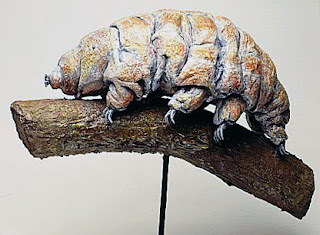quite tricky little creatures.
Their original name was: bear-animalcule
 |
| under the microscope this is the face of the creature |
 |
| This is the cellular structure it is made up of. It has a hardcase shell around the outside to protect it from death and other mites eating away at its exterior |
 |
| the Water Bear Description Tardigrades are microscopic animals found in a variety of marine, freshwater and terrestrial habitats. They are often present in soil and litter, but seldom noticed by us due to their minute size - the majority of tardigrades are 0.3-0.5 mm in length. Tardigrada were first discovered in 1773, when German naturalist and parish priest J.A.E. Goeze observed a freshwater tardigrade and called it a “Kleiner Wasser Bär”, a “little water bear”. In 1776, the Italian abbot and professor of natural history Lazzaro Spallanzani gave these animals their present name — “Il Tardigrado” (“slow ones”) (Nelson and Higgins, 1990). As these names imply, tardigrades have a micro-ursine appearance — with four pairs of short stumpy legs equipped with large claws — and walk slowly. Tardigrades are often white, or colourless and more or less transparent; some are brown, yellow, orange, pink, red or green. The body colour can reflect the pigmentation of the body cuticle itself, or can be due to the gut contents showing through the colourless body wall. Tardigrada have no specialized larval stage, and juveniles look like miniature adults. The tardigrade taxonomy is based primarily on the morphology of claws, cuticle, and mouth apparatus. Notes on Biology Most tardigrades feed on plants, but a few species are carnivorous, feeding on soil nematodes and other minute soil animals, including other tardigrades. The tardigrade mouth contains a pair of stylets, and they feed by piercing plant or animal cells with the stylets, and sucking out the cell contents. Similar to nematods and rotifers, tardigrads exhibit cryptobiosis (“hidden life”), a bizarre ability to dehydrate and slow down metabolic rate when environmental conditions are unfavourable. In the state of cryptobiosis tardigrades are able to withstand severe dessication, high pressure, and extremely low temperatures (such as being plunged into liquid nitrogen!). A tardigrade can survive in this state for more than 10 years, and sometimes more than a 120 years. Life span is less than a year otherwise. Where to find them? Essentially aquatic animals, all Tardigrada live in the thin water film on the surface of wet terrestrial substrates. Tardigrades are commonly found on the surface of mosses, lichens and liverworts, which cover stones and trees. Some tardigrades can be also found in the top 1-2 cm of many soils, and in leaf litter. To find tardigrades, collect samples of moss or plant litter. First, spread moss samples in a thin layer, and leave at room temperature until dry. Then, place dried sample into a container with water for several hours to rehydrate. Agitate the sample, then squeeze out and discard the moss (litter). After the excess water is decanted, the remaining sediment will contain live tardigrades. To observe them, examine the sediment in a small amount of water under a dissecting microscope, at magnification x30 or higher. Boiling water or 75% alcohol can be used to fix tardigrades. They should be stored in alcohol for preservation. Distribution and conservation The ability of tardigrades to withstand long periods of dehydration probably contributes to their dispersal throughout the world, as eggs, cysts and anhydrobiotic adults are disseminated by wind, water, and migrating animals. Many genera and species are cosmopolitan. Tardigrades are found throughout New Zealand. The diversity and ecology of Tardigrada are not well studied, and their role in ecosystems and conservation value are unknown. http://soilbugs.massey.ac.nz/tardigrada.php there is a lot of links about the NZ tardigrada and books to look in also. Te Papa has information on this also |




We can use the structure of the shell outercase to guide our design of the parasitic technology?
ReplyDeleteElle